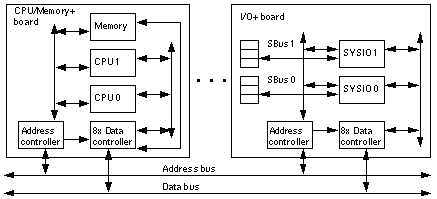Basic Definitions for the Card Cage
When locating a board slot in the 8-slot and 16-slot card cages, remember:
Table B-1 Card Cage Definitions|
Slot numbers |
Even-numbered slots are at the front of the card cage. Odd-numbered slots are at the back. |
|
|
In the front of the card cage, slot 0 is at the top. At the rear of the card cage, slot 1 is at the top. |
|
|
The component side of a board is down in the front slots. The component side is up in the rear slots. |
|
|
For specific slot numbers, see Appendix B, "Enterprise 4500 Standalone Server". |
|
Slot functions |
All card cage slots are equivalent in the Enterprise 6500, 5500, and 4500 systems. However, it is suggested that you install I/O+ boards at the back of the cage to simplify the installation of interface cables. Install CPU/Memory+ boards at the front of the cage to leave the rear slots for I/O+ boards. If all slots are filled on one side of the cage, you can use the other side. |
|
|
Slot 1 should contain an I/O+ board connected to the boot disk. (This is a suggestion, and not a requirement.) |
|
|
Slot 0 should contain a CPU/master board with at least one CPU. The POST diagnostics display more messages if slot 0 contains a CPU/Memory+ board and a CPU. For an explanation, see the next item, "Master board." |
|
Master board |
The first CPU/Memory+ board (in slot 0) functions temporarily as a master board during some POST tests. There is no master board during normal system operations after the POST tests have finished. |
Enterprise card cages feature a centerplane bus. Boards at the front of the centerplane must be installed component side down, while boards at the back must be installed component side up. The boards are oriented this way to allow for minimum signal trace lengths and optimum system performance.
Figure B-1 illustrates the logical organization of Enterprise systems.
Figure B-1 Enterprise System Logical Organization

There are few differences between board slots and each slot can accept any board type. However, an I/O+ board should be installed in slot 1 since this slot connects directly to the internal media tray through the centerplane and related cables. The internal tape and/or CD-ROM or other optional internal SCSI drives cannot be used unless an I/O+ board is present in slot 1.
Although the remaining slots are equivalent, I/O+ boards should be located on the back side of the centerplane for easy access to interface cables at the rear of the cabinet.
- © 2010, Oracle Corporation and/or its affiliates
